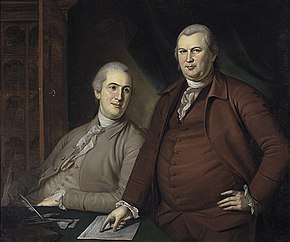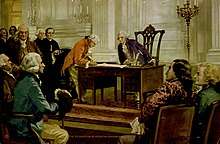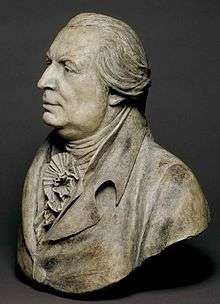Gouverneur Morris
Gouverneur Morris (January 30, 1752 – November 6, 1816) was an American statesman, a Founding Father of the United States, and a signatory to the Articles of Confederation and the United States Constitution. He wrote the Preamble to the United States Constitution and has been called the "Penman of the Constitution."[1] In an era when most Americans thought of themselves as citizens of their respective states, Morris advanced the idea of being a citizen of a single union of states.[2] He represented New York in the United States Senate from 1800 to 1803.
Gouverneur Morris | |
|---|---|
%2C_1817.jpg) | |
| United States senator from New York | |
| In office April 3, 1800 – March 3, 1803 | |
| Preceded by | James Watson |
| Succeeded by | Theodorus Bailey |
| 4th United States Minister to France | |
| In office June 3, 1792 – April 9, 1794 | |
| President | George Washington |
| Preceded by | William Short |
| Succeeded by | James Monroe |
| Personal details | |
| Born | January 30, 1752 Province of New York, British America |
| Died | November 6, 1816 (aged 64) New York, U.S. |
| Resting place | Saint Ann's Episcopal Church, The Bronx |
| Political party | Federalist |
| Spouse(s) | |
| Children | Gouverneur Morris II |
| Alma mater | Columbia University |
Morris was born into a wealthy landowning family in what is now New York City. After attending King's College (now Columbia), he studied law under Judge William Smith and earned admission to the bar. He was elected to the New York Provincial Congress before serving in the Continental Congress. After losing re-election to Congress, he moved to Philadelphia and became the assistant U.S. superintendent of finance. He represented Pennsylvania at the 1787 Constitutional Convention, where he advocated a strong central government. He served on the committee that wrote the final draft of the United States Constitution.
After the ratification of the Constitution, Morris served as Minister Plenipotentiary to France. He criticized the French Revolution and the execution of Marie Antoinette. Morris returned to the United States in 1798 and won election to the Senate in 1800, affiliating with the Federalist Party. He lost re-election in 1803. After leaving the Senate, he served as chairman of the Erie Canal Commission.
Early life

Morris was born on January 30, 1752, the son of Lewis Morris Jr. (1698–1762) and his second wife, Sarah Gouverneur (1714–1786). Morris' first name derived from his mother's surname; she was from a Huguenot family that had first moved to Holland, and then to New Amsterdam.[3] According to Abigail Adams, Morris' first name was pronounced "governeer".[4] In Dutch and in French, Gouverneur means "Governor".
Morris' half-brother Lewis Morris was a signer of the Declaration of Independence. Another half-brother, Staats Long Morris, was a loyalist and major-general in the British army during the American Revolution, and his grandfather, Lewis Morris, was the chief justice of New York and British governor of New Jersey.
His nephew, Lewis Richard Morris, served in the Vermont legislature and in the United States Congress. His grandnephew was William M. Meredith, United States Secretary of the Treasury under Zachary Taylor.
Morris' father, Lewis Morris, was a wealthy landowner and judge. Gouverneur Morris was born on the family estate, Morrisania, on the north side of the Harlem river, which was at the time in Westchester County, but is now part of the Bronx. Morris, a gifted scholar, enrolled at King's College, now Columbia University in New York City, at age 12. He graduated in 1768 and received a Master's degree in 1771. He studied law with Judge William Smith and attained admission to the bar in 1775.
Career
On May 8, 1775,[5] Morris was elected to represent his family household in southern Westchester County (now Bronx County), in the New York Provincial Congress. As a member of the congress, he, along with most of his fellow delegates, concentrated on turning the colony into an independent state. However, his advocacy of independence brought him into conflict with his family, as well as with his mentor, William Smith, who had abandoned the patriot cause when it pressed toward independence. Morris was a member of the New York State Assembly in 1777–78.
After the Battle of Long Island in August 1776, the British seized New York City. His mother, a loyalist, gave his family's estate, located across the Harlem River from Manhattan, to the British for military use.
Continental Congress
Morris was appointed as a delegate to the Continental Congress and took his seat in Congress on 28 January 1778. He was selected to a committee in charge of coordinating reforms of the military with George Washington. After witnessing the army encamped at Valley Forge, he was so appalled by the conditions of the troops that he became the spokesman for the Continental Army in congress and subsequently helped enact substantial reforms in its training, methods, and financing. He also signed the Articles of Confederation in 1778, and was its youngest signer.
In 1778, when the Conway Cabal was at its peak, some members of the Continental Congress attempted a no-confidence vote against George Washington. If it had succeeded, then George Washington would have been court-martialed and dismissed as Commander-in-Chief of the Continental Army. At that time, Gouverneur Morris cast the decisive tie-breaking vote in favor of keeping George Washington as Commander-in-Chief.[6]
Lawyer and merchant

In 1779, he was defeated for re-election to Congress, largely because his advocacy of a strong central government was at odds with the decentralist views prevalent in New York. Defeated in his home state, he moved to Philadelphia, Pennsylvania, to work as a lawyer and merchant.
In 1780, Morris had a carriage accident in Philadelphia, and his left leg was amputated below the knee. Despite an automatic exemption from military duty because of his handicap and his service in the legislature, he joined a special "briefs" club for the protection of New York City, a forerunner of the modern New York Guard.
Public office

In Philadelphia, he was appointed assistant superintendent of finance of the United States, serving under Robert Morris.[7] He was selected as a Pennsylvania delegate to the Constitutional Convention in 1787. During the Convention, he was a friend and ally of George Washington and others who favored a strong central government. Morris was elected to serve on a committee of five (chaired by William Samuel Johnson) who drafted the final language of the proposed constitution. Catherine Drinker Bowen, in her 1966 book Miracle at Philadelphia, called Morris the committee's "amanuensis," meaning that it was his pen that was responsible for most of the draft, as well as its final polished form.[8]
It is said by some that Morris was "an aristocrat to the core," who believed that "there never was, nor ever will be a civilized Society without an Aristocracy".[9] It is also alleged that he thought that common people were incapable of self-government because he feared that the poor would sell their votes to the rich and that voting should be restricted to property owners. Duff Cooper wrote of Morris that although he "had warmly espoused the cause of the colonists in the American War of Independence, he retained a cynically aristocratic view of life and a profound contempt for democratic theories."[10]
Morris opposed admitting new western states on an equal basis with the existing eastern states, fearing that the interior wilderness could not furnish "enlightened" national statesmen.[11] Madison's summary of Morris' speech at the Convention, on 11 July 1787, said that his view "relative to the Western Country had not changed his opinion on that head. Among other objections it must be apparent they would not be able to furnish men equally enlightened, to share in the administration of our common interests." His reason given for that was regional: "The Busy haunts of men not the remote wilderness, was the proper school of political Talents. If the Western people get the power into their hands they will ruin the Atlantic interests." In this fear, he turned out to be in the minority. Jon Elster has suggested that Morris' attempt to limit the future power of the West was a strategic move designed to limit the power of slaveholding states, because Morris believed that slavery would predominate in new Western states.[12]
At the convention he gave more speeches than any other delegate, a total of 173. As a matter of principle, he often vigorously defended the right of anyone to practice his chosen religion without interference, and he argued to include such language in the Constitution.[13]
Views on slavery

Gouverneur Morris was one of the few delegates at the Philadelphia Convention who spoke openly against domestic slavery. According to James Madison, who took notes at the Convention, Morris spoke openly against slavery on 8 August 1787, saying that it was incongruous to say that a slave was both a man and property at the same time:
- He [Morris] never would concur in upholding domestic slavery. It was a nefarious institution. It was the curse of heaven on the states where it prevailed. Compare the free regions of the Middle States, where a rich & noble cultivation marks the prosperity & happiness of the people, with the misery & poverty which overspread the barren wastes of Va. Maryd. & the other States having slaves. ... Proceed southwardly, and every step you take, through the great regions of slaves, presents a desert increasing with the increasing proportion of these wretched beings.
- Upon what principle is it that the slaves shall be computed in the representation? Are they men? Then make them citizens, and let them vote. Are they property? Why, then, is no other property included? The Houses in this city [Philadelphia] are worth more than all the wretched slaves which cover the rice swamps of South Carolina.
According to Madison, Morris felt that the U.S. Constitution's purpose was to protect the rights of humanity and that to promote slavery was incongruous with it:
- The admission of slaves into the Representation when fairly explained comes to this: that the inhabitant of Georgia and S. C. who goes to the Coast of Africa, and in defiance of the most sacred laws of humanity tears away his fellow creatures from their dearest connections & damns them to the most cruel bondages, shall have more votes in a Govt. instituted for protection of the rights of mankind, than the Citizen of Pa. or N. Jersey who views with a laudable horror, so nefarious a practice.[15]
Minister Plenipotentiary to France

He went to France on business in 1789 and served as Minister Plenipotentiary to France from 1792 to 1794. His diaries during that time have become a valuable chronicle of the French Revolution, capturing much of the turbulence and violence of that era, as well as documenting his affairs with women there. Unlike Thomas Jefferson, Morris was far more critical of the French Revolution and considerably more sympathetic to the deposed queen consort, Marie Antoinette.[16] Commenting on her grandfather's sometimes Tory-minded outlook of the world, Anne Cary Morris said, "His creed was rather to form the government to suit the condition, character, manners, and habits of the people. In France this opinion led him to take the monarchical view, firmly believing that a republican form of government would not suit the French character."[17] The "French character" in the Age of Revolution was one of two socio-political extremes: absolutism and autocracy.
Morris was "the only foreign representative who remained in his post throughout the worst days of the Terror."[18] On one occasion, when Morris "found himself the centre of a hostile mob in favour of hanging him on the nearest lamp-post, he unfastened his wooden leg, brandished it above his head, and proclaimed himself an American who had lost a limb fighting for liberty", upon which "[t]he mob's suspicions melted into enthusiastic cheers" (even though, as noted above, Morris had in fact lost his leg as a result of a carriage accident).[19]
While Morris was minister, Marquis de Lafayette, who had been an important participant in the American Revolution, was exiled from France and his family imprisoned, and Thomas Paine, another important figure, was arrested and imprisoned in France. Morris' efforts on their behalf have been criticized as desultory and insufficient.[20][21] After a change of the French government, and after Morris was replaced as minister, his successor, James Monroe, was able to secure Paine's release.
United States Senate
He returned to the United States in 1798 and was elected in April 1800, as a Federalist, to the United States Senate, filling the vacancy caused by the resignation of James Watson. He served from May 3, 1800 to March 3, 1803 and was defeated for re-election in February 1803.
Later career
On 4 July 1806, he was elected an honorary member of the New York Society of the Cincinnati.
After leaving the U.S. Senate, he served as Chairman of the Erie Canal Commission from 1810 to 1813. The Erie Canal helped to transform New York City into a financial capital, the possibilities of which were apparent to Morris when he said "the proudest empire in Europe is but a bubble compared to what America will be, must be, in the course of two centuries, perhaps of one."[22]
He was one of the three men who drew up the Commissioners' Plan of 1811, which laid out the Manhattan street grid.[23]
Morris was elected a member of the American Antiquarian Society in 1814.[24]
Personal life
_(14578228560).jpg)
Until he married late in life, Morris' diary tells of a series of affairs. His lovers included the French novelist Adelaide Filleul and the American poet and novelist Sarah Wentworth Apthorp Morton.[25]
In 1809, at age 57, he married 35-year-old Ann Cary Randolph (1774–1837), nicknamed "Nancy", who was the daughter of Ann Cary and Thomas Mann Randolph Sr., and the sister of Thomas Mann Randolph Jr.[26] Thomas Mann Randolph Jr. was the husband of Thomas Jefferson's daughter, Martha Jefferson Randolph. Nancy lived near Farmville, Virginia, with her sister Judith and Judith's husband Richard Randolph on a plantation called Bizarre.[27] In April 1793, Richard Randolph and Nancy were accused of murdering a newborn baby which was said to be Nancy's; presumably she had been having an affair with Richard.[28] Richard stood trial; he was defended by Patrick Henry and John Marshall, who obtained an acquittal.[29] Richard Randolph died suddenly in 1796; both sisters were suspected, but nothing was proven.[30] Nancy remained at Bizarre after her brother-in-law's death but was asked to leave by Judith in 1805.[31]
Nancy traveled north and lived in Connecticut before agreeing in 1809 to work as a housekeeper for Morris, whom she had known previously.[32] They soon decided to marry; Morris was apparently undisturbed by the rumors that had caused Nancy to leave Virginia.[33] By all accounts, their marriage was a happy one;[34] they had a son, Gouverneur Morris Jr., who went on to a long career as a railroad executive.[35]
Morris died on November 6, 1816, after causing himself internal injuries and an infection while using a piece of whalebone as a catheter to attempt clearing a blockage in his urinary tract.[36][37] He died at the family estate, Morrisania, and was buried at St. Ann's Church in The Bronx.[38]
Descendants
Morris's great-grandson, also named Gouverneur Morris (1876–1953), was an author of pulp novels and short stories during the early twentieth century. Several of his works were adapted into films, including the famous Lon Chaney film The Penalty in 1920.[39][40]
Legacy
Morris established himself as an important landowner in northern New York, where the Town of Gouverneur[41] and Village of Gouverneur in St. Lawrence County are named after him.
In 1943, a United States liberty ship SS Gouverneur Morris was launched.[42] She was scrapped in 1974.
References
- Documents from the Constitutional Convention and the Continental Congress. Library of Congress.
- Wright, Jr., Robert K. (1987). "Gouverneur Morris". Soldier-Statesmen of the Constitution. United States Army Center of Military History. CMH Pub 71-25. Retrieved 2009-06-02.
- "Gouverneur Morris [1752–1816]". New Netherlands Institute. Retrieved 17 June 2014.
- Brookhiser, Richard (Spring 2002). "The Forgotten Founding Father". City Journal. New York, NY: Manhattan Institute for Policy Research.
- ANB "Gouverneur Morris"
- "The True George Washington", written by Paul Leicester Ford, published by J. Lippincott, the printing of the year 1900
- Raphael, Ray (2009). Founders: The People Who Brought You a Nation. New York, NY: The New Press. p. 404. ISBN 978-1-59558-327-7.
- Bowen, Catherine Drinker. Miracle at Philadelphia. 1986 edition. p. 236.
- "Toward An American Revolution". Cyberjournal.org. Archived from the original on 2010-06-07. Retrieved 2010-03-19.
- Duff Cooper, Alfred (2001) [1932]. Talleyrand. New York: Grove Press. p. 43. ISBN 0802137679.
- Bowen. p. 178.
- Jon Elster, Securities Against Misrule, (2013), pp. 79–80
- Gregg Frazer. "Gouverneur Morris, Theistic Rationalist". Allacademic.com. p. 26. Retrieved 2010-03-19.
- Robinson, Raymond H. "The Marketing of an Icon". George Washington: American Symbol. p. 117.
Figure 56 John Henry Hintermeister (American 1869-1945) Signing of the Constitution, 1925...Alternatively labeled Title to Freedom and the Foundation of American Government...".
- James Madison (1787). "James Madison, The Debates in the Several State Conventions of the Adoption of the Federal Constitution vol. 5 [1827]". Retrieved 2009-07-29.
- Antonia Fraser, Marie Antoinette: The Journey, (2002), p. 476; Vincent Cronin, Louis and Antoinette, (1974), p. 295.
- Anne Cary Morris, ed.,"The Diary and Letters of Gouverneur Morris; Minister of the United States to France; Member of the Constitutional Convention, etc.," (1888), Vol. I, p. 15.
- Duff Cooper, Alfred (2001) [1932]. Talleyrand. New York: Grove Press. pp. 43–44. ISBN 0802137679.
- Duff Cooper, Alfred (2001) [1932]. Talleyrand. New York: Grove Press. p. 44. ISBN 0802137679.
- Whitridge, Arnold (July 1976). "A Representative of America". American Heritage. 27 (4). Retrieved 12 June 2019.
- Conway, Moncure D. (1893). The Life of Thomas Paine. G.P. Putnam's Sons.
- Will Wilkinson from the July 2004 issue (July 2004). "The Fun-Loving Founding Father: Gouverneur Morris, the First Modern American". Reason. Retrieved 2010-03-19.
- Morris, Gouverneur, De Witt, Simeon, and Rutherford, John [sic] (March 1811) "Remarks Of The Commissioners For Laying Out Streets And Roads In The City Of New York, Under The Act Of April 3, 1807". Accessed May 7, 2008.
- American Antiquarian Society Members Directory
- Brookhiser, Richard (Spring 2002). "The Forgotten Founding Father". City Journal. Retrieved December 4, 2018.
- Roosevelt, Theodore (1888). Gouverneur Morris. Boston, MA: Houghton, Mifflin and Company. p. 340.
Gouverneur Morris married randolph.
- Kierner, Cynthia A. (2004). Scandal at Bizarre: Rumor and Reputation in Jefferson's America. Charlottesville, VA: University of Virginia Press. p. vii. ISBN 978-0-8139-2616-2.
- Clinton, Catherine (1982). The Plantation Mistress: Woman's World in the Old South. New York, NY: Pantheon Books: Random House. p. 114. ISBN 9780394722535.
- Kirschke, James J. (2005). Gouverneur Morris: Author, Statesman, and Man of the World. New York, NY: Thomas Dunne Books: St. Martin's Press. p. 263. ISBN 978-0-312-24195-7.
- Kirschke, Gouverneur Morris, p. 263
- Kierner, Scandal at Bizarre, pp. 91–92
- Hines, Emilee (2009). It Happened in Virginia: Remarkable Events That Shaped History. Guilford, CT: Morris Book Publishing, LLC. p. 47. ISBN 978-0-7627-5424-3.
- Kirschke, Gouverneur Morris, pp. 263–264
- Morris, Jr., Seymour (2010). American History Revised: 200 Startling Facts That Never Made it Into the Textbooks. New York, NY: Broadway Books: Random House. p. 121. ISBN 978-0-307-58760-2.
- Elizabeth Spencer-Ralph and Gloria McDarrah (October 1979). "National Register of Historic Places Registration: St. Ann's Church Complex". New York State Office of Parks, Recreation and Historic Preservation. Archived from the original on 2012-03-19. Retrieved 2011-01-12.
- Adams, William Howard (2003). Gouverneur Morris: an independent life. Yale University Press. ISBN 0-300-09980-0.
- Kirschke, James J. (2005). Gouverneur Morris: author, statesman, and man of the world. Macmillan. ISBN 0-312-24195-X.
- Lehman College Art Gallery
- "Browse By Author: M – Project Gutenberg". Gutenberg.org. 1916-07-01. Retrieved 2010-03-19.
- "Gouverneur Morris". Imdb.com. 2009-05-01. Retrieved 2010-03-19.
- Gannett, Henry (1905). The Origin of Certain Place Names in the United States. Govt. Print. Off. pp. 140.
- "Kaiser Oregon Shipbuilding". shipbuildinghistory.com. Archived from the original on 2009-12-12. Retrieved 2009-11-28.
Further reading
- Brookhiser, Richard (2003). Gentleman Revolutionary: Gouverneur Morris, the Rake Who Wrote the Constitution. New York: Free Press. ISBN 0-7432-2379-9.
- Crawford, Alan Pell (2000). Unwise Passions: A True Story of a Remarkable Woman—and the First Great Scandal of Eighteenth-century America. New York: Simon & Schuster. ISBN 0-684-83474-X. (A biography of Morris's wife.)
- Fresia, Jerry (1988). Toward an American Revolution: Exposing the Constitution & Other Illusions. Cambridge: South End Press.
- Heyburn, Jack (2017). "Gouverneur Morris and James Wilson at the Constitutional Convention," University of Pennsylvania Journal of Constitutional Law. 20: 169–198.
- Miller, Melanie Randolph, Envoy to the Terror: Gouverneur Morris and the French Revolution (Potomac Books, 2005)
- The Diary and Letters of Gouverneur Morris, Minister of the United States to France; Member of the Constitutional Convention, ed. Anne Cary Morris (1888). 2 vols. online version
- The Life of Gouverneur Morris, with Selections from his Correspondence and Miscellaneous Papers; Detailing Events in the American Revolution, the French Revolution, and in the Political History of the United States, ed. Jared Sparks (1832). 3 vols. Boston: Gray & Bowen.
- Swiggert, Howard (1952). The Extraordinary Mr. Morris. New York: Doubleday & Co. loc 52-5540.
External links
| Wikisource has original works written by or about: Gouverneur Morris I |
| Wikimedia Commons has media related to Gouverneur Morris. |
| Wikiquote has quotations related to: Gouverneur Morris |
- United States Congress. "Gouverneur Morris (id: M000976)". Biographical Directory of the United States Congress.
- Mintz, Max, Gouverneur Morris, George Washington's War Hawk, Virginia Quarterly Review, Autumn 2003.
- Gouverneur Morris Letters
- Gouverneur Morris, Jr. Papers,1853–1879 New-York Historical Society
- Gouverneur Morris Papers, Rare Book and Manuscript Library, Columbia University,New York, NY
| Diplomatic posts | ||
|---|---|---|
| Preceded by William Short |
U.S. Minister Plenipotentiary to France 1792–1794 |
Succeeded by James Monroe |
| U.S. Senate | ||
| Preceded by James Watson |
U.S. senator (Class 1) from New York 1800–1803 Served alongside: John Armstrong, Jr., De Witt Clinton |
Succeeded by Theodorus Bailey |


